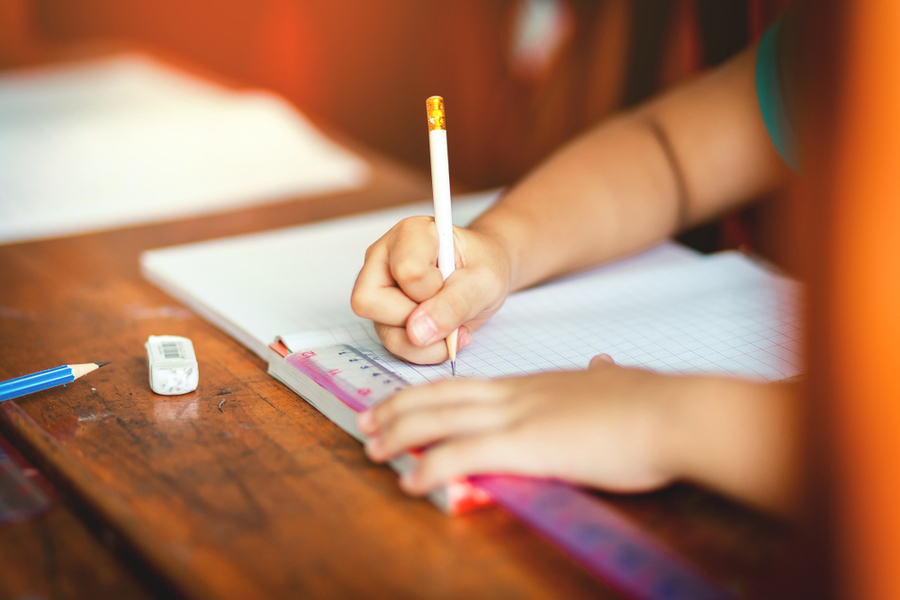Dysgraphia [dis-gra-fee-uh] is a learning disability that makes it difficult for a person to handwrite and organize written expression. Dysgraphia is not related to one's ability to read, nor is it related to a person's intelligence. The word dysgraphia comes from the Greek word dys meaning difficulty and graph meaning writing letters. The suffix -ia refers to it being a condition. For a person with dysgraphia, the difficulty is in the production of letters, words and sometimes even thoughts on a page.
As children learn to read and write, the production of letters and words should gradually become automatic. When this does not happen after a few years of instruction, a child is sometimes tested to see if a learning disorder is present. Tests may show that the muscle movement or visual spacial development required for writing may be impeded due to a neurological problem known as dysgraphia. The child's sloppy, often illegible, handwriting is usually the first sign.
How Dysgraphia Differs from Dyslexia
Dyxlexia and dysgraphia are both learning disabilities related to language. Both language difficulties are neurological. Those who suffer from dyslexia have difficulty processing reading, while those with dysgraphia have difficulty producing writing. In some cases, people suffer from both dyslexia and dysgraphia. Other learning difficulties such as speech impairment and ADD may also be present. While many kids with learning disabilities have trouble handwriting, dysgraphia can, and often does, exist in isolation.
Types of Dysgraphia
Dysgraphia refers generally to a difficulty in writing. However, there are three main types of dysgraphia that result from different neurological weaknesses. Some people have a combination of all three types. Others suffer from only one type. It is important to identify the specific type of dysgraphia that a student suffers from in order to know which coping strategies will work best. The expectations of a teacher, parent, and student can change when a diagnosis is made.
- Spatial Dysgraphia: In this case, the person has difficulty with spacing and organization when writing. Letters or numbers will all blend together, and the person will have trouble writing in a straight line. Drawing is also difficult. This student may spell orally without difficulty.
- Motor Dysgraphia: For this type the problem lies solely in fine motor skills related to muscle movement. This person will likely have trouble writing letters and drawing lines, shapes, or pictures due to improper pencil grip and arm positioning. This student may spell orally without difficulty. Other fine motor skills may not be affected.
- Dyslexic Dysgraphia: The true problem here lies in the dyslexia, and the processing of language. Copied text typically appears quite normal, but text that is written spontaneously may be illegible. Oral spelling is likely problematic as well. The dyslexia causes the dysgraphia.
Symptoms and Warning Signs of Dysgraphia
There is more to dysgraphia than simply poor handwriting. If a student displays very poor handwriting in addition to a number of the following symptoms and warning signs, a test for dysgraphia may be a good idea:
- experiences writing fatigue from poor pencil grip (cramping hand and fingers)
- has difficulty spacing, or creating columns (letters or numbers run together)
- omits letters or syllables regularly
- has poor spelling on the page, but can spell well orally
- avoids tasks that involve writing
- uses both cursive and print
- uses mainly uppercase letters
- can't put thoughts into words
- can't think of what to write or where to start the writing process
- has trouble writing and thinking at the same time
- takes a long time to write a small amount
- writes very quickly to get the task done; the result is illegible
- speaks out loud/whispers while writing
- has difficulty drawing
- may hold his/her writing arm awkwardly
- has trouble touching thumb to other fingers on same hand
- has difficulty reading back/editing own work
Strategies for Coping with Dysgraphia
- use paper with raised lines (for young learners)
- use paper with large spaces between the lines
- try graph paper for mathematics
- practise moving one's arm back and forth across a page without a pencil
- play with clay and other modeling materials, practise forming letters
- practise mazes and connecting the dots
- practise making letters with numbered arrows that show the direction of the strokes
- don't focus on neatness for assessment
- experiment with a wide range of writing utensils; allow the student to choose
- change expectations for the amount of writing that is required
- identify the point at which the student begins to struggle in a writing assignment
- experiment with printing and cursive
- practise air writing
- provide models of proper organization based on completing one small step at a time
- teach students to pull down strokes when writing instead of pushing up
- teach proper posture (no slouching or sitting on knees, keep feet on the ground)
- practise locking the arm/wrist in a good position
- work on proper paper position; hold the paper with the other hand
- take writing breaks, such as rubbing hands together for a few seconds
- make sure student uses planning and organization strategies such as mapping
- try using speech recognition tools
- create checklists for proofreading
- provide notes for the student so that content isn't lost
- assess knowledge in ways other than writing
- teach and encourage the use of abbreviations
- teach keyboarding skills with correct fingering
- don't isolate students by having them stay longer to finish
- allow voice recordings
Some Famous People with Dysgraphia
The following famous people were diagnosed with dysgraphia or are believed to have suffered from it:
- Agatha Christie – crime novellist
- Thomas Edison – scientist
- Albert Einstein – scientist
- George Patton – US army general
- Henry Winkler – film director, actor
Source: HealthResearchFunding.org
